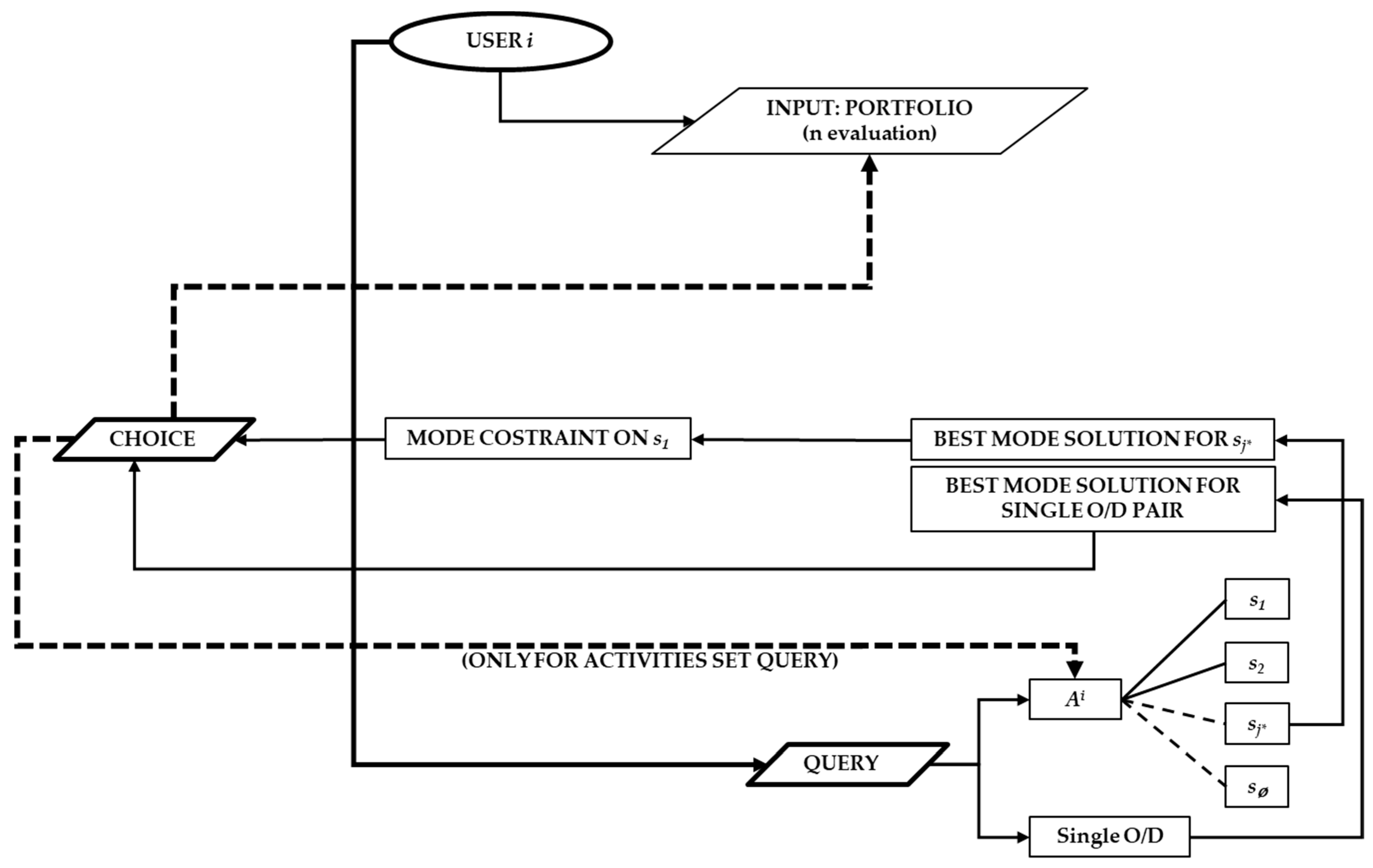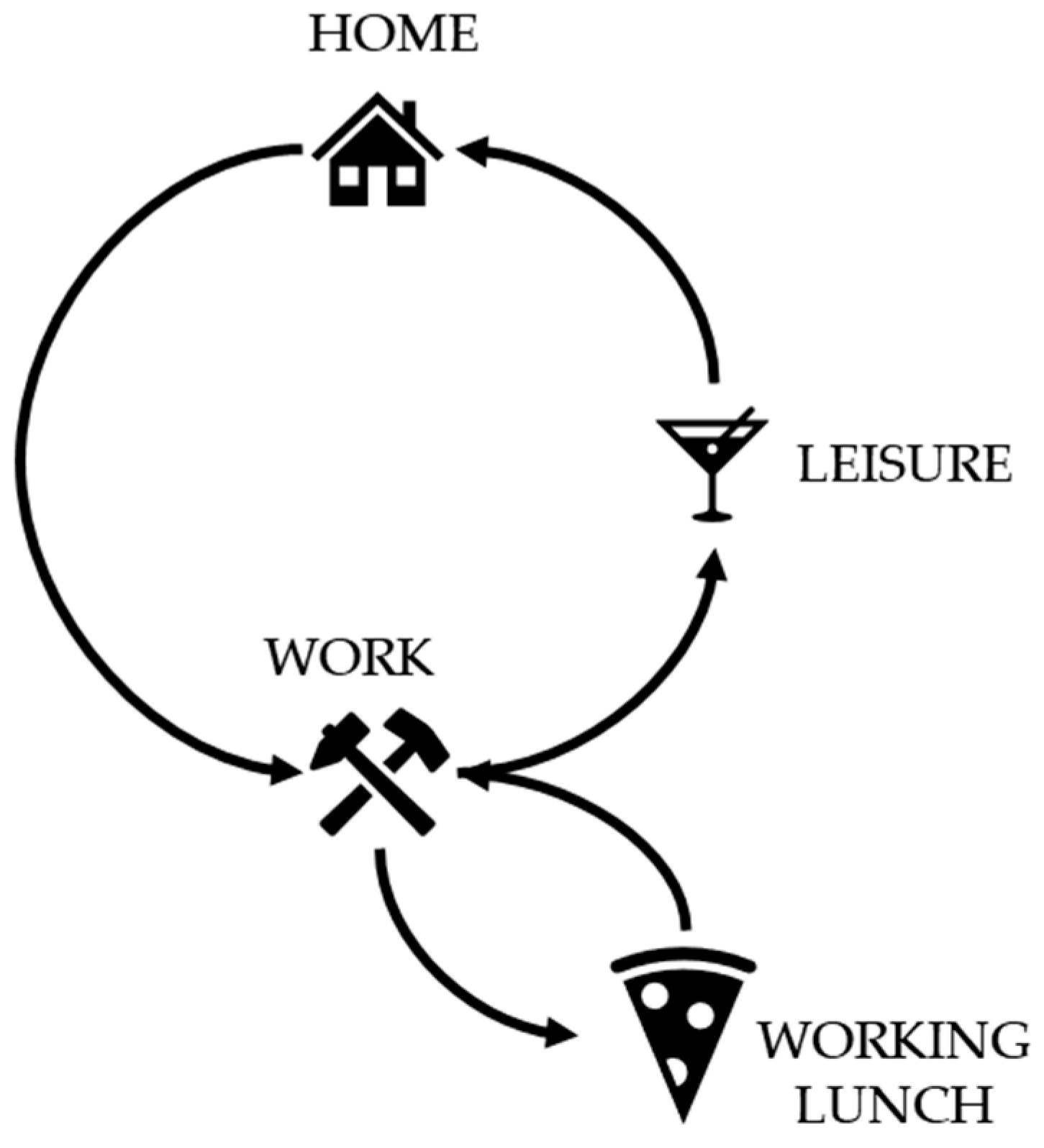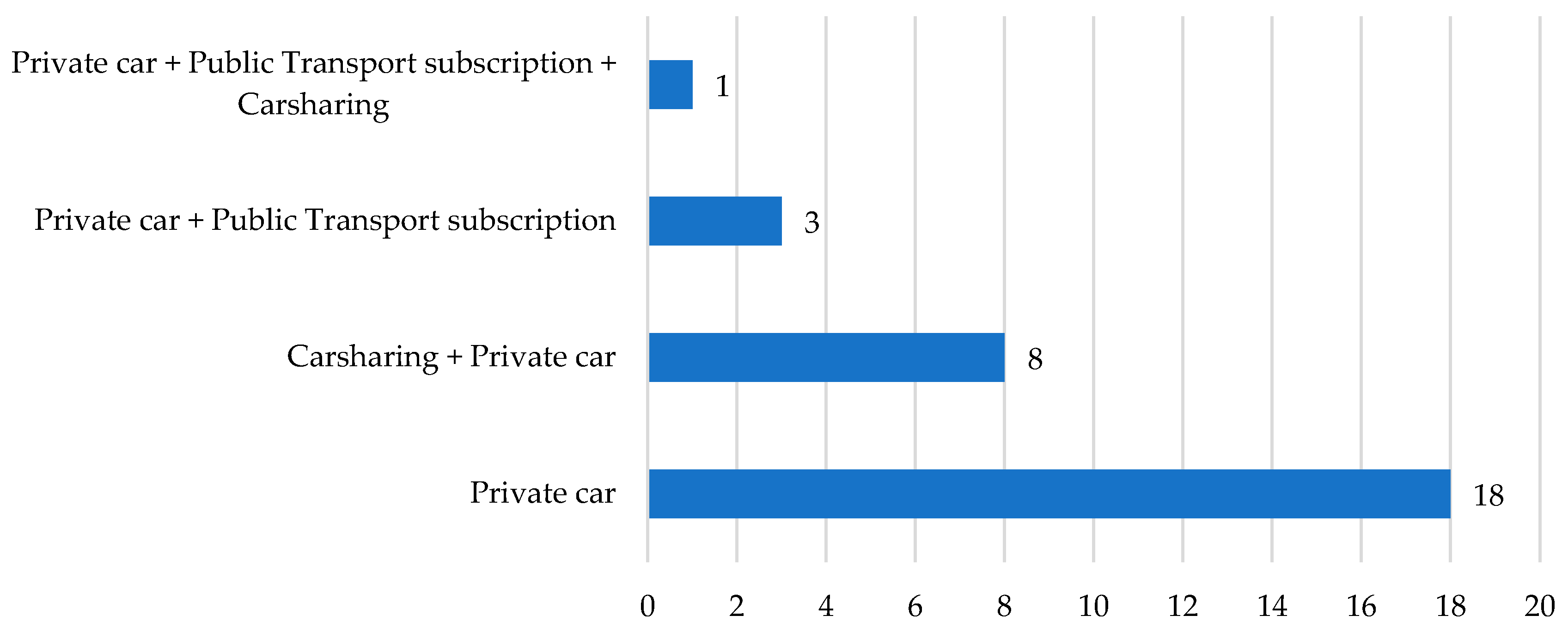A Framework for Dynamic Advanced Traveler Information Systems
Abstract
1. Introduction
2. Background
3. Logical Architecture of the Dynamic Advanced Traveler Information System (ATIS)
- USER CHARACTERISTICS (top left of the framework). The user defines the personal portfolio of holdings (box PORTFOLIO in the framework); here, the parameter n, which represents the number of available resources, is defined.
- INPUT OF THE PROCEDURE (bottom right of the framework). User’s query (box QUERY in the framework) enables two distinct procedures:
- 2a. In the simpler case of a single O/D pair, the system provides the mode alternative with the shortest travel time. Next, the portfolio is updated on the basis of the actual choice made by the user (dashed thick arrow from CHOICE to PORTFOLIO in the framework).
- 2b. In the more complex case of a set of activities, the set Ai is decomposed as previously indicated, and the most critical activity is identified. Through a simulation procedure, like in the case of single O/D pair, the optimal solution for the critical activity is identified. The choice of this alternative for the critical trip could binds the mode choice for the first trip of the chain (MODE COSTRAIN ON s1 in the framework).
- In this case, not only is the portfolio (as in the case of a single O/D pair) updated on the basis of the choice made, but also the set of activities (dashed thick arrow from CHOICE to Ai).
- 3.
- UPDATE (dashed thick arrow in the framework). Based on the choice made by the user i (box CHOICE in the framework) the update procedure occurs: portfolio update for the case 2a; portfolio and the set of activities for the case 2b.
4. Results from a Pilot Test in Rome (Italy)
- User portfolio acquisition from the survey;
- Evaluation of the critical trip according to user resources availability (portfolio);
- Evaluation of the best mode choice for the critical trip (constrain on the mode choice at the activity chain level);
- Calculation of the overall travel time spent for the activity chain proposed in the survey.
5. Discussion and Conclusions
Author Contributions
Funding
Institutional Review Board Statement
Informed Consent Statement
Data Availability Statement
Conflicts of Interest
References
- Rehrl, K.; Bruntsch, S.; Mentz, H.-J. Assisting Multimodal Travelers: Design and Prototypical Implementation of a Personal Travel Companion. IEEE Trans. Intell. Transp. Syst. 2007, 8, 31–42. [Google Scholar] [CrossRef]
- Bhat, C.R.; Singh, S.K. A comprehensive daily activity-travel generation model system for workers. Transp. Res. Part A Policy Pract. 2000, 34, 1–22. [Google Scholar] [CrossRef]
- Cirillo, C.; Axhausen, K.W. Mode choice in complex tours: A panel analysis. In Arbeitsberichte Verkehrs- und Raumplanung; Institut für Verkehrsplanung und Transportsysteme, ETH Zürich: Zürich, Switzerland, 2002; Volume 142. [Google Scholar]
- Ramadurai, G.; Srinivasan, K.K. Dynamics and Variability in Within-Day Mode Choice Decisions: Role of State Dependence, Habit Persistence, and Unobserved Heterogeneity. Transp. Res. Rec. J. Transp. Res. Board 2006, 1977, 43–52. [Google Scholar] [CrossRef]
- Hensher, D.A.; Reyes, A.J. Trip chaining as a barrier to the propensity to use public transport. Transportation 2000, 27, 341–361. [Google Scholar] [CrossRef]
- Ho, C.Q.; Mulley, C. Multiple purposes at single destination: A key to a better understanding of the relationship between tour complexity and mode choice. Transp. Res. Part A Policy Pract. 2013, 49, 206–219. [Google Scholar] [CrossRef]
- Esztergár-Kiss, D.; Rózsa, Z.; Tettamanti, T. An activity chain optimization method with comparison of test cases for different transportation modes. Transp. A Transp. Sci. 2019, 16, 293–315. [Google Scholar] [CrossRef]
- Florido-Benitez, L.; del Alcazar, B. Airports as ambassadors of the marketing strategies of spanish tourist destination. Gran Tour 2020, 21, 47–78. [Google Scholar]
- Florido-Benítez, L. Influencia de las características demográficas y situacionales en la satisfacción y toma de decisiones de las actividades turísticas a través del mobile marketing. Cuad. Tur. 2016, 38, 147–169. [Google Scholar] [CrossRef][Green Version]
- Florido-Benítez, L.; Del Alcázar, B.; Gonzalez, E.M. Impact of mobile marketing on passengers’ satisfaction and experience at airports. J. Airpt. Manag. 2017, 11, 58–74. [Google Scholar] [CrossRef]
- Boakye, K.; Khattak, A.; Liu, J.; Nambisan, S. How Do Smartphone and Non-Smartphone Users Access and Use Travel Information? Evidence from the 2014 Puget Sound Regional Household Travel Survey. In Proceedings of the Transportation Research Board 96th Annual Meeting, Washington, DC, USA, 8–12 January 2017. [Google Scholar]
- Chorus, C.G.; Molin, E.J.E.; Van Wee, B. Use and Effects of Advanced Traveler Information Services (ATIS): A Review of the Literature. Transp. Rev. 2006, 26, 127–149. [Google Scholar] [CrossRef]
- Adler, J.L.; Blue, V.J. Toward the design of intelligent traveler information systems. Transp. Res. Part C Emerg. Technol. 1998, 6, 157–172. [Google Scholar] [CrossRef]
- Polak, J.; Jones, P. The acquisition of pre-trip information: A stated preference approach. Transportation 1993, 20, 179–198. [Google Scholar] [CrossRef]
- Khattak, A.; Polydoropoulou, A.; Ben-Akiva, M. Modelling revealed and stated pre-trip travel response to advanced traveler information systems. Transp. Res. Rec. J. Transp. Res. Board 1996, 1537, 46–54. [Google Scholar] [CrossRef]
- Srinivasan, K.; Mahmassani, H.S. Role of Congestion and Information in Trip-Makers’ Dynamic Decision Processe: Experimental Investigation. Transp. Res. Rec. J. Transp. Res. Board 1999, 1676, 44–52. [Google Scholar] [CrossRef]
- Chen, P.S.; Mahmassani, H.S. Dynamic interactive simulator for studying commuter behavior under real-time traffic information supply strategies. Transp. Res. Rec. J. Transp. Res. Board 1993, 1413, 12–21. [Google Scholar]
- Mahmassani, H.S.; Liu, Y.-H. Dynamics of commuting decision behaviour under advanced traveller information systems. Transp. Res. Part C Emerg. Technol. 1999, 7, 91–107. [Google Scholar] [CrossRef]
- Ye, H.; Xiao, F.; Yang, H. Day-to-day dynamics with advanced traveler information. Transp. Res. Part B Methodol. 2021, 144, 23–44. [Google Scholar] [CrossRef]
- Chen, P.; Srinivasan, K.; Mahmassani, H. Effect of Information Quality on Compliance Behavior of Commuters under Real-Time Traffic Information. Transp. Res. Rec. J. Transp. Res. Board 1999, 1676, 53–60. [Google Scholar] [CrossRef]
- Nuzzolo, A.; Crisalli, U.; Comi, A.; Rosati, L. A personalized advisor on multimodal network: Some theoretical and applicative issues. In Proceedings of the 10th European ITS Congress, Helsinki, Finland, 23–24 August 2014. [Google Scholar]
- Chen, B.; Ding, Z.; Wu, Y.; Zhou, J.; Chen, Y. An optimal global algorithm for route guidance in advanced traveler information systems. Inf. Sci. 2021, 555, 33–45. [Google Scholar] [CrossRef]
- Dotoli, M.; Zgaya, H.; Russo, C.; Hammadi, S. A Multi-Agent Advanced Traveler Information System for Optimal Trip Planning in a Co-Modal Framework. IEEE Trans. Intell. Transp. Syst. 2017, 18, 2397–2412. [Google Scholar] [CrossRef]
- Zhang, J.; Liao, F.; Arentze, T.; Timmermansa, H. A multimodal transport network model for advanced traveler information systems. Procedia Comput. Sci. 2011, 5, 912–919. [Google Scholar] [CrossRef]
- Van Nes, R. Design of Multimodal Transport Networks: A Hierarchical Approach. Ph.D. Thesis, Delft University of Technology, Delft, The Netherlands, 2002. [Google Scholar]
- Esztergár-Kiss, D.; Csiszár, C. Evaluation of multimodal journey planners and definition of service levels. Int. J. Intell. Transp. Syst. Res. 2015, 13, 154–165. [Google Scholar] [CrossRef]
- Zhang, L.; Li, J.-Q.; Zhou, K.; Gupta, S.; Li, M.; Zhang, W.-B.; Misener, J. Traveler Information Tool with Integrated Real-Time Transit Information and Multimodal Trip Planning. Transp. Res. Rec. J. Transp. Res. Board 2011, 2215, 1–10. [Google Scholar] [CrossRef]
- Le Vine, S.; Lee-Gosselin, M.; Sivakumar, A.; Polak, J. A new concept of accessibility to personal activities: Development of theory and application to an empirical study of mobility resource holdings. J. Transp. Geogr. 2013, 31, 1–10. [Google Scholar] [CrossRef]
- Patella, S.M.; Sportiello, S.; Petrelli, M.; Carrese, S. Workplace relocation from suburb to city center: A case study of Rome, Italy. Case Stud. Transp. Policy 2019, 7, 357–362. [Google Scholar] [CrossRef]
- Patella, S.M.; Scrucca, F.; Asdrubali, F.; Carrese, S. Traffic simulation-based approach for a cradle-to-grave greenhouse gases emission model. Sustainability 2019, 11, 4328. [Google Scholar] [CrossRef]
- Rapporto Mobilità 2019. Available online: https://romamobilita.it/it/media/pubblicazioni/rapporto-mobilita-2019 (accessed on 9 July 2021).
- Carrese, S.; Giacchetti, T.; Nigro, M.; Patella, S.M. An innovative car sharing electric vehicle system: An italian experience. Urban Transp. XXIII 2017, 176, 245–252. [Google Scholar] [CrossRef]
- Rotaris, L.; Danielis, R.; Maltese, I. Carsharing use by college students: The case of Milan and Rome. Transp. Res. Part A Policy Pract. 2019, 120, 239–251. [Google Scholar] [CrossRef]




| Age | 18–25 | 26–35 | 36–45 | 46–55 | 56–65 | |
| % | 3% | 53% | 17% | 3% | 23% | |
| Household size | 1 | 2 | 3 | 4 | 5 | |
| % | 7% | 20% | 23% | 47% | 3% | |
| Driving licenses | ||||||
| Household size | 1 | 2 | 3 | 4 | 5 | |
| 1 | 100% | - | - | - | - | |
| 2 | 17% | 83% | - | - | - | |
| 3 | - | 43% | 57% | - | - | |
| 4 | - | 36% | 43% | 21% | - | |
| 5 | - | - | - | - | 100% | |
| i | sj* | USER Choice (j*) | tj* USER (Min) | ATIS Choice (j*) | tj* ATIS (Min) | Tchain USER (Min) | Tchain ATIS (Min) | ∆Tchain |
|---|---|---|---|---|---|---|---|---|
| 1 | L–H | Private Car | 30 | Private Car | 30 | 112 | 112 | 0.0% |
| 2 | L–H | Public Transport | 45 | Private Car | 35 | 142 | 110 | −22.5% |
| 3 | W–L–W | Private Car | 27 | Private Car | 27 | 130 | 130 | 0.0% |
| 4 | H–W | Private Car | 36 | Private Car | 36 | 123 | 123 | 0.0% |
| 5 | H–W | Private Car | 45 | Private Car | 45 | 137 | 137 | 0.0% |
| 6 | W–L | Private Car | 40 | Public Transport | 30 | 150 | 110 | −26.7% |
| 7 | W–L | Private Car | 40 | Public Transport | 35 | 170 | 120 | −29.4% |
| 8 | L–H | Public Transport | 80 | Private Car | 45 | 180 | 165 | −8.3% |
| 9 | W–L | Private Car | 40 | Public Transport | 35 | 150 | 120 | −20.0% |
| 10 | H–W | Private Car | 50 | Private Car | 50 | 158 | 158 | 0.0% |
| 11 | L–H | Private Car | 48 | Private Car | 48 | 166 | 166 | 0.0% |
| 12 | H–W | Private Car | 45 | Private Car | 45 | 153 | 153 | 0.0% |
| 13 | H–W | Private Car | 60 | Private Car | 60 | 160 | 160 | 0.0% |
| 14 | W–L | Private Car | 40 | Public Transport | 38 | 145 | 118 | −18.6% |
| 15 | L–H | Private Car | 40 | Private Car | 40 | 155 | 155 | 0.0% |
| 16 | W–L | Private Car | 40 | Public Transport | 38 | 145 | 128 | −11.7% |
| 17 | W–L | Private Car | 40 | Public Transport | 38 | 145 | 141 | −2.8% |
| 18 | W–L | Private Car | 40 | Public Transport | 38 | 140 | 131 | −6.4% |
| 19 | W–L | Public Transport | 38 | Public Transport | 38 | 128 | 128 | 0.0% |
| 20 | W–H | Public Transport | 38 | Public Transport | 38 | 118 | 118 | 0.0% |
| 21 | H–W | Private Car | 55 | Private Car | 55 | 170 | 170 | 0.0% |
| 22 | L–H | Private Car | 55 | Private Car | 55 | 163 | 163 | 0.0% |
| 23 | H–W | Private Car | 65 | Private Car | 65 | 190 | 190 | 0.0% |
| 24 | H–W | Private Car | 65 | Private Car | 65 | 175 | 175 | 0.0% |
| 25 | H–W | Public Transport | 57 | Private Car | 53 | 180 | 171 | −5.0% |
| 26 | W–L–W | Private Car | 45 | Public Transport | 40 | 172 | 144 | −16.3% |
| 27 | W–L–W | Public Transport | 40 | Private Car | 37 | 163 | 122 | −25.2% |
| 28 | W–L–W | Public Transport | 40 | Private Car | 37 | 167 | 127 | −24.0% |
| 29 | H–W | Public Transport | 45 | Private Car | 42 | 151 | 141 | −6.6% |
| 30 | H–W | Public Transport | 38 | Public Transport | 38 | 141 | 141 | 0.0% |
| TOTAL | 4579 | 4227 | −7.7% | |||||
Publisher’s Note: MDPI stays neutral with regard to jurisdictional claims in published maps and institutional affiliations. |
© 2021 by the authors. Licensee MDPI, Basel, Switzerland. This article is an open access article distributed under the terms and conditions of the Creative Commons Attribution (CC BY) license (https://creativecommons.org/licenses/by/4.0/).
Share and Cite
Carrese, F.; Carrese, S.; Patella, S.M.; Petrelli, M.; Sportiello, S. A Framework for Dynamic Advanced Traveler Information Systems. Future Transp. 2021, 1, 590-600. https://doi.org/10.3390/futuretransp1030031
Carrese F, Carrese S, Patella SM, Petrelli M, Sportiello S. A Framework for Dynamic Advanced Traveler Information Systems. Future Transportation. 2021; 1(3):590-600. https://doi.org/10.3390/futuretransp1030031
Chicago/Turabian StyleCarrese, Filippo, Stefano Carrese, Sergio Maria Patella, Marco Petrelli, and Simone Sportiello. 2021. "A Framework for Dynamic Advanced Traveler Information Systems" Future Transportation 1, no. 3: 590-600. https://doi.org/10.3390/futuretransp1030031
APA StyleCarrese, F., Carrese, S., Patella, S. M., Petrelli, M., & Sportiello, S. (2021). A Framework for Dynamic Advanced Traveler Information Systems. Future Transportation, 1(3), 590-600. https://doi.org/10.3390/futuretransp1030031








